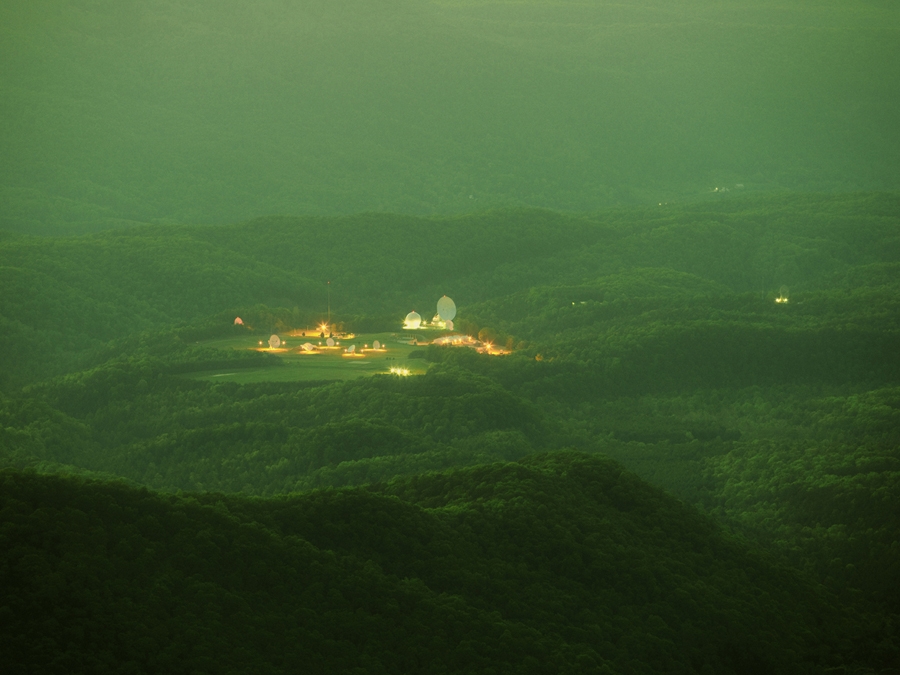‘It’s the oldest question of all, George. Who can spy on the spies?’ So asks Control of Smiley in John le Carré’s Tinker, Tailor, Soldier, Spy (1974). Is there a real-life version of the omniscient John Tracy, stranded in splendid isolation on Thunderbird 5? Trevor Paglen looks a strong candidate for this mission, should he choose to accept it. High-quality surveillance work preferred. This show provides the evidence and features three aspects of Paglen’s work, a video and examples from two photographic projects. As with the paranoid aesthetic of novelists Thomas Pynchon and Don DeLillo, or the pencil diagrams of Mark Lombardi, we are firmly encamped in a geography of dangerous times. This is a place viewed by the Eye of Providence where the soundtrack is SIGINT – signals intelligence. And where the motto of our observers might be altitudo cum habitus – to consider from on high. This, we learn, Paglen has gleaned from the leaked insignia of a 1998 launch of a classified spacecraft out of Cape Canaveral.
The Limit Telephotography series has Paglen sneakily use cameras and astronomical telescopes to uncover classified government sites. These are often in the deserts of the Western states, miles from anywhere. So we get N5177C at Gold Coast Terminal (2007), taken in Nevada at a distance of one mile. Or Large Hangars and Fuel Storage (2005), again taken from Nevada, a shot of the Tonopah Test Range at a distance of 18 miles. There is something of Thomas Demand’s autistic stare at work in these pictures. What’s going on here? We don’t know for sure, but you can bet it will end badly for someone. And there’s the voyeuristic frisson of seeing what we are not meant to see. We have been let in on a secret. These are horizontal ground views, what Google Maps will never capture.
In contrast there is The Other Night Sky series, vertical photographs of the heavens above, polluted by our space junk. KEYHOLE/IMPROVED CRYSTAL Near Scorpio (Optical Reconnaissance Satellite; USA 129) (2007) is an image of a satellite that can apparently provide a linear resolution of approximately 10cm, enough to detect a human face, if not your new paradigm spectacles. A white streak traverses a warm orange-coloured liquefied sky, as vividly sensational as Frederic Edwin Church’s Cotopaxi (1862). KEYHOLE IMPROVED CRYSTAL from Glacier Point (Optical Reconnaissance Satellite; USA 186) (2008) captures more rotational scratches of orbital activity above Yosemite. We are immediately reminded of Ansel Adams or Eadweard Muybridge perching above the void. And here another dimension of Paglen’s output is suggested. He appears to be redefining the imagery of America’s Manifest Destiny. This, of course, was a catchphrase of American expansionism from the mid-nineteenth century.
Could Paglen be considered, then, as a late transcendentalist? Vast prospects of the view from on high are indeed what we get here, the sublime bespoiled, corrupted by incipient violence. One might see him as an inheritor of Church or Thomas Cole, albeit one who rejects a metaphorical approach to war. There is no hint of redemption. For Paglen, the agency and its friends are modern Davy Crockett types – minus the cute coonskin hat – bent on conquest. This is reinforced by the video Drone Vision (2010), which shows intercepted footage by an amateur ‘satellite hacker’ of drone surveillance. Drones are controlled by operatives thousands of miles away from the ground being viewed. Grainy shots of farmers in tractors way down below, oblivious of their watchers in the sky. Whisper it; Paglen is peeping on the peepers. This review will self-destruct in five seconds.
John Quin
